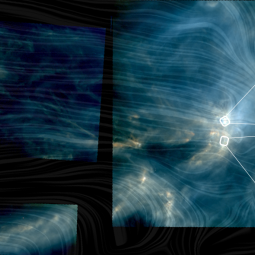By Dennis Lee and Joan Schmelz
Paper:
HAWC+/SOFIA Polarimetry in L1688: Relative Orientation of Magnetic Field and Elongated Cloud Structure
Lee, Dennis, et al., 2021/09, ApJ, 918, 39.
Despite recent progress driven by improved observational capabilities, the role of magnetic fields in the stellar birth process remains poorly understood. Initial steps toward greater understanding resulted when data from the Planck satellite were used to construct magnetic field maps for ten relatively nearby star forming regions. By comparing the maps with the orientations of elongated structures, the Planck team discovered that the plane-of-sky magnetic field is preferentially parallel to the orientation of elongated structures at lower column densities but preferentially perpendicular at higher column densities. This transition is also seen in magnetohydrodynamic simulations, but only when they include reasonably strong magnetic fields. Simulations where the magnetic field is weak compared with turbulence showed no such transition.
This critical transition was observed on spatial scales near the angular resolution limit of Planck. The HAWC+ instrument on SOFIA provides much higher resolution while still incorporating sufficient information at larger spatial scales to overlap with Planck. The combination, which extends from much larger to much smaller than the critical scale, allows the transition to be more fully characterized. For both Planck and HAWC+, the magnetic field structures are determined from the polarization of thermal emission from magnetically aligned dust grains.
The rate at which new stars are born within giant molecular clouds depends on complex interactions between gravity, turbulence, and the magnetic field. On the scales of clouds and cloud cores, a strong magnetic field can slow the collapse due to magnetic pressure/tension. On smaller scales, the field can transfer angular momentum away from infalling gas, facilitating protostellar collapse. Truly understanding the role of the magnetic field in star formation requires the ability to probe these fields across a range of spatial scales: from the clouds (tens of parsecs) down to the cores (< 0.1 pc) and below.
L1688, part of the Rho Ophiuchus cloud complex, is the closest site of clustered star formation to the Sun. The Planck and SOFIA observations together cover scales ranging from 3 pc (the size of L1688) down to 0.02 pc. While the Planck data for Ophiuchus are highly suggestive of a transition in this region, the addition of the higher-resolution HAWC+ data at the high column densities provides confirmation. Therefore, the large-scale magnetic field in L1688 has an energy density comparable to or greater than that of turbulent gas motions.
By comparing the Planck and SOFIA measurements with a set of magnetohydrodynamic simulations of molecular clouds formed by colliding flows, researchers estimated the threshold volume density where the outward magnetic force balances the inward gravitational force. The value found for L1688 was approximately 10 4 molecules per cm 3 , notably higher than a previously reported result made using line-of-sight estimates of the magnetic field from Zeeman splitting. One possible explanation for the discrepancy is cloud-to-cloud differences since the Zeeman estimate corresponds to an average across many clouds.
Looking forward, it is feasible to extend the methods applied here to other clouds. It is equally important to explore how the estimated threshold volume density might change with different simulation assumptions and observational constraints. These results will help deepen our understanding of the role of magnetism in star formation and how it may vary from cloud to cloud.
